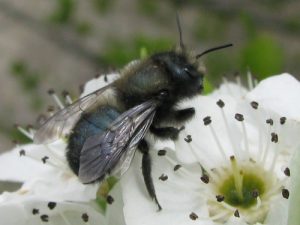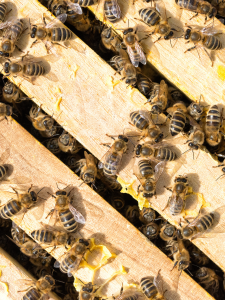When you read the word “bee,” what comes to mind? Is it an image of a honeybee? If so, you are in the company of most people. Not many would argue the sweet benefits of this insect. However, for me, I picture the clumsy, round bumblebee. I can sometimes identify with these bees as they haphazardly fly from flower to flower. There are yet many other bees out there. No matter which one you picture, they all serve an important role in nature and, even more importantly, our food ecosystem. They are so important we have a day designated to celebrate all the world’s bees.
About World Bee Day
In 2014 the major Beekeepers’ Association of the Republic of Slovenia backed the initiative for May 20th to be declared World Bee Day. The initiative passed. Then with the backing of the International beekeepers’ organization Apimondia, the idea spread to the United Nations. In December 2017, the UN General Assembly approved a resolution to designate May 20th World Bee Day.
This day aims to raise awareness of the importance of bees and the protection of bees and other pollinators. It is geared to support the industry bees bring (honey and beeswax products), their importance in food production, and keeping three-quarters of the world’s plants pollinated.
The Bumblebee

Before the European Honeybee was introduced to the Americas, many different native species of bees worked hard at pollinating our native plants and fruits. Possibly the hardest worker was the bumblebee. Bumblebees are North America’s only native social bee. A queen hibernates over the winter and then emerges in the spring. She starts feeding on spring flowers as she looks for an underground burrow for her nest. She is the primary caregiver for her developing brood. After her first young hatch, they start gathering food and taking care of the nest. While they are mild-mannered while foraging, they will sting to defend their nest.
What makes bumblebees so great for pollination?
If you look closely, they have very hairy bodies. These hairs collect pollen, and the bee uses its combed feet to brush most of it out to pouches. The pollen they do not reach is transferred and pollinates the next flower (if they are the same flowers). Unlike honeybees, bumblebees can collect pollen while hanging from a flower. They also use what is called buzz pollination. This is where the bee vibrates its wings shaking the flower. The pollen then rains down on their hairy body where it is collected. This makes them the best pollinator for tomatoes, peppers, and blueberries, all of which have flowers that hang down.
Blue Orchard Bee

Another native bee, the Blue Orchard bee, is an excellent pollinator of, as its name implies, orchards. They are excellent for pollinating plum, pear, and peach trees and another excellent pollinator for blueberries. In nature, they will utilize hollow tubes made by wood-boring insects and animals. They will also nest in handmade tubes and bee houses. Because they will use paper tubes for their nests, they can be collected and sold commercially to commercial fruit growers and even homeowners. You can make a house for these and other mason bees out of a block of wood, and you can keep track of when a bee uses the tube by looking for plugged openings. In the following spring, when the fruit trees start blooming, the new bees will emerge and start the process.
The honey bee

We cannot have a bee article without mentioning the Honey bee. These bees are not native and came from Europe with the early settlers in the 17th century. While they play an essential role in agriculture, they are not always the most efficient at pollinating plants like pumpkins, blueberries, and cherries. What they lack in efficiency, they make up in numbers. According to the USGS website “Are honey bees native to North America,” “in one year, a honey bee hive can collect 40 pounds of pollen and 265 pounds of nectar.” Besides honey, we also get beeswax, pollen, royal jelly, and propolis. With all the services and products that honey bees provide, the industry is worth 100’s of millions of dollars.
Depending on your location, you may have a local beekeeper association. In Putnam County, we have the Beekeepers of Putnam County Florida. They provide education and experience on keeping honey bees. Other educational opportunities include the UF/IFAS Bee College; this is an event for any experience level. This multi-day event cover topics on beginner beekeeping, in-hive experience, research updates, and much more.
Ways to celebrate World Bee Day
- Buy honey from a local beekeeper.
- Join the Beekeepers of Putnam County Florida or your local beekeeper association.
- Plant some wildflowers or flowering bushes.
- Place some bee boxes for mason bees
- Use bee-friendly pesticides
For more information:
World Bee Day
Beekeepers of Putnam County Facebook Page
UF/IFAS Honey Bee Research and Education Lab
FDACS Bees/Apiary Website
 0
0
